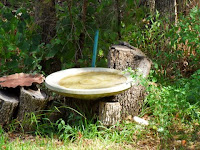 |
| I really doubt that this native plant is dead; next spring it'll be green and healthy |
A plant with shrivelled, brown leaves, or no leaves at all, may not really be dead. Cutting it down or pulling it up may be a mistake.
Clearly we've endured a hot, dry summer. Some plants are looking like they're through with this world. But north Texas has had many, many hot, dry summers in the past; this summer was nothing new. Native plants have learned how to adapt.
A very common adaptation is dormancy. Many native trees and shrubs go dormant when under severe stress - looking like they would in the winter. Next spring they'll probably put out new, green leaves as if nothing had happened. Just like they have for many centuries!
(Of course if a plant stays dormant too long, if the soil's bad or for some other environmental reasons, it'll really die.)
In the meantime I suggest you keep taking care of "brown-leaf trees" as if they looked healthy: which for native plants means doing hardly anything. Actually, giving them a lot of extra water during dormancy may, in fact, kill them.
The Blue Jay we see throughout north Texas is thought of
as a bird that doesn't migrate. Which is true much of the time. A few flocks, however, are what are called "partial migrators". They don't migrate to South America - they'll just relocate a hundred miles or so. They'll sometimes move to a slightly warmer area with more abundant food - maybe just to the adjacent county or merely down a mountainside, into a valley. One place these "partial migrators" may move is into urban areas, since the 'heat island' effect makes it a few degrees warmer. It's just one of the birds that contributes to north Texas having more birds in cool weather, than in the summer. Even if they stay put, like most of them do, there are plenty of Blue Jays in north Texas in both January and July.











